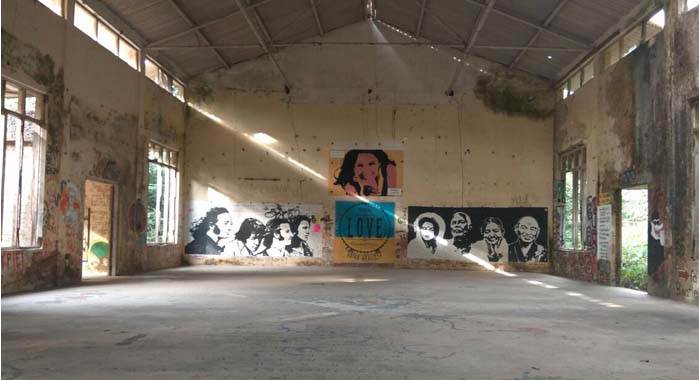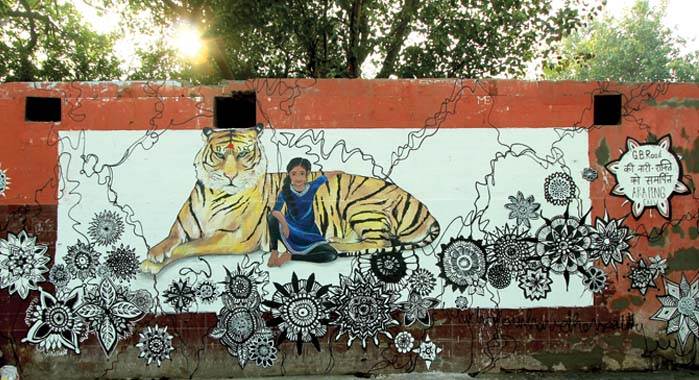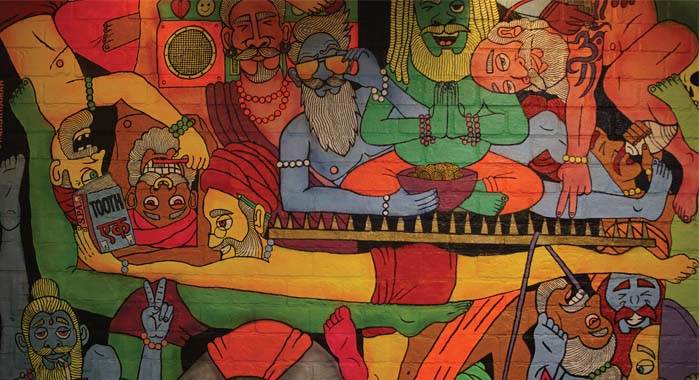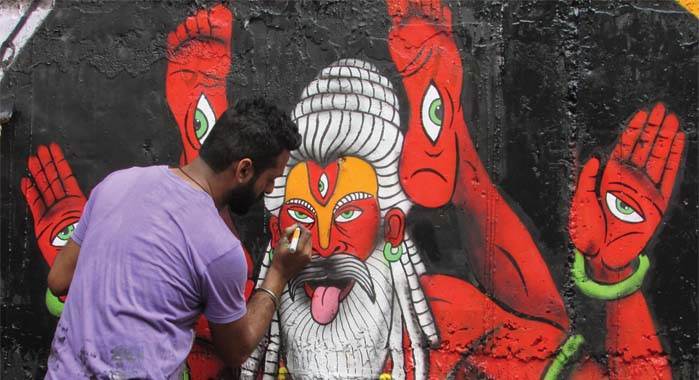No one owns painting or the murals that have been rendered on the walls of the street. It is the best way to catch the eyeballs of the people walking past by the roads during their daily routine, be it in busy city streets or the sedimentary life in Rishikesh.
During my trip, I encountered murals on the streets plus the banks of the Ganges. To satiate my curiosity, I asked the friendly neighbourhood shopkeeper in Rishikesh. That is how I was introduced to Harsh Raman. The shopkeeper was full of praise about Raman's wizardry.
Another spot in Rishikesh where I witnessed Harsh Raman’s art was at the Beatles Ashram aka Maharishi Ashram. The Beatles arrived in India in 1968 to train in the practice of transcendental meditation from Maharishi Mahesh Yogi. They stayed in the ashram for a year. Hence the name: Beatles Ashram. Artists and hippies from all over the world are part of this rock music pilgrimage. Some of them painted a piece of their soul on the walls of the ashram.

Remnants of the Beatles ashram in Rishikesh, Uttarakhand
Harsh Raman, creative director at Harkat Studios believes ‘art is imagination brought to life’. According to him, art should not be restricted to the museums and galleries where the majority of folks are art intellectuals or have pedagogy on their side. Art should be available for all. All the power and experience that one imbibes inside galleries, vanishes as one steps out.
R Harsh says, “Art has been in Indian culture since aeons. Be it: Madhubani art and even cave frescoes.” That's how he realised that all that he needed was a wall, a semi-decent brush and colours to portray his message – rather playfully – to the world.

Mural at New Delhi's GB Road highlights women empowerment
R Harsh feels that women are undervalued for the service they do. He wanted to tell the tale of ordinary women who are "extraordinary". For this project, he along with the all-women team from Germany arrived at the GB Road, the red-light zone of Delhi.One thing that caught the attention of R Harsh was the protectiveness of the sex-workers towards their children. Artists from Germany wanted to bring out the relationship between a mother and a child in such an environment through their art.
Harsh Raman answers ten questions from Sujith Ail about his approach towards street art
You are an urban artist from Delhi? What attracted you to street art?
I love to create vibrant murals which encourage people to think out of the box and celebrate life. I am a firm believer that “art should be for everyone” and has the power to open the mind of the viewer to the real ecstasy of being alive, which is far away from consumerist pursuits and materialistic distractions. I want to have a positive impact on society and street art is a tool to do so.
When did you get into street art? Till now, how many places have you covered in India as well as abroad?
I started quite early doing graffiti or simply writing poetry on walls. I have always been a storyteller and just wanted to share my stories and experiences with the world without a middleman involved. With time my words evolved into a more refined form of visual art. Since 2012, I have been doing big walls, collaborating with international artists and taking on commissions. I love to travel and try to paint every chance that I get. My art can be found all over India and even at international locations such as London, Paris and Melbourne.
Do you have government backing for these type of initiatives?
Sometimes the government is kind enough to help in whichever way they can. More often with providing walls to do large-scale murals on and sometimes with special permissions.
What is the response from the locals? Do they consider murals art in a bit different way?
The response is overwhelming. Initially, people don’t understand the reason behind me painting a wall in their locality. But once they get their head around the fact that the art is for them without any cost or hidden agenda, they quite appreciate it. It also gives me an opportunity to have meaningful conversations with them, get to know about their lives and open them up to art. They have different interpretations of the meaning behind the art but it also brings communities together and creates a new conversation between a space and its inhabitants.
What was your objective behind the Rishikesh project? I heard from the locals that in 2016, there was an art festival in Rishikesh, were you a part of it?
My wall is part of the Rishikesh street art festival 2016. Since the place is known for yoga and spirituality, taught by various “babas”, during one of my walks I met a sadhu sitting in the corner of an empty street. We ended up talking for hours. I learnt a lot from that conversation. Later I picked an ignored street corner to create my art. There is so much information available online yet the wisdom that a conversation with a mystic sitting in some street corner can humble you and open you to new experiences. It’s like you never know what you will find if you look closely and pay attention. Rishikesh is an amazing place with such magical experiences. I decided to create my own graffiti baba which represents a fusion of the old mystic yogic culture and the new loud pop generation. The sadhu is me.
Describe your experience in Rishikesh as compared to all other places that you have worked in?
It was very good. I got the opportunity to meet some amazing people. The people were really warm and open-minded. I also picked up some yoga asanas and breathing techniques which have really helped me live a more balanced life. It’s good to be able to come into people's lives as an observer, share their experiences and then carry on with your own journey. I love Rishikesh and have a lot of friends there now.
You do only spray painting? Or you deploy brushes too? Since these materials have a cost attached to it, how do you manage the funding?
Money has never been an issue. I earn enough to be able to spend on my personal creations. It’s my way of giving back to society. For other murals, they are funded by the client or the festival organisers or whosoever has commissioned the mural. I mix and match different materials but prefer to work with spray paints.
The surface of the wall might be rough and varies as compared to the canvas. So what are the difficulties that you face while painting?
No difficulties. The way I see it is that each surface has a story to tell and a history behind it. I like painting such surfaces; they have more life in them compared to a blank canvas. I just use my skills to enhance the story and give it a more immersive visual form, which people can enjoy.
How do you start your painting? Since the final art might be 10x10ft, what is the initial process?
I am very spontaneous with my process. I just let the wall speak to me and start drawing with a chalk or paint. Once I feel that I am headed in the right direction I begin adding more life to colours. It’s very organic. It just flows through me. I am not really aware of where it is going while I am immersed in the process.
Tell me about your art at the Beatles ashram?
Yes, I have created some graffiti in the Beatles ashram. I just landed up there on one of my walks. It was a fascinating place which seemed to have a lot of history. I began to introspect on life and put a few lines here and there which talk about my experience and leanings in Rishikesh. My favourites are – “You cannot run from your demons. You can only slay them” and “You only live as long as you are remembered.” Beatles ashram is adorned by many travelling artists, some of whom are good friends of mine. It’s a lovely place to sit and connect the dots in your own life.
On 16 December 2017, Harkat Studios held an event in Mumbai – “16mm Film Festival” where all the films were screened on an analogue 16mm projector. This event was supported by Kodak where it sponsored the 16mm film festival on found footage and 16mm film, giving people hands-on experience of working with the film through a workshop. Hersh Lulla of Kodak said, “It is same as the print in a way, where we feel the industry is at a cusp in digital versus print, same is with the film where even though digital is the medium of choice, there is a revival in film and its use in film projects.”
Harkat Studios is an international art boutique based in Mumbai, Delhi and Berlin. Its team comprises of designer and filmmaker Karan Talwar; researcher, filmmaker and German organiser Michaela Strobel; illustrator and street artist Harsh Raman and creative producer Iti Agarwal.



















 See All
See All